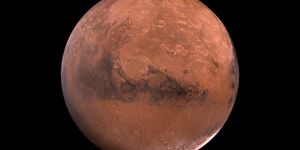The Science Behind the First Powered Flight on Another Planet
NASA’s upcoming Mars 2020 mission involves much more than just another land-based rover – it will also pioneer the very first powered flight on another planet besides Earth. The lucky air vehicle will be a tiny and lightweight autonomous helicopter-like drone that will buzz around in Mars’ atmosphere as it photographs the world beneath it. But it’s not as easy as it sounds…
Mars’ atmosphere is incredibly thin, and so there’s less air there than there is here on Earth. With that in mind, the Mars 2020 air vehicle will need to spin its rotors between 2,300-2,900 RPM, or approximately five times that of a traditional helicopter here on Earth, to move enough air to stay in flight.
While the air situation is a bit of a disadvantage for the Mars 2020 air vehicle, one thing it has going for it is that Mars has approximately 30% less gravitational influence than the Earth, which should make the aircraft lighter. The smaller weight footprint, paired with the faster rotor speed, should allow the vehicle to perform its job.
You’ll notice that we call this the first ‘powered’ flight on another planet, and that’s because the Soviet Union performed an ‘unpowered’ flight with a pair of helium balloon spacecraft on Venus in 1985. Given the circumstances, there’s a lot of new technology going into this mission, and it’s certain to help us learn more about the red planet as we prepare to send the first human explorers in the next few decades.








